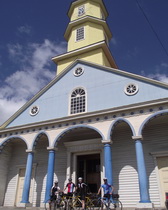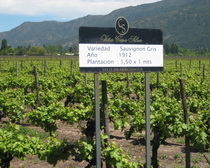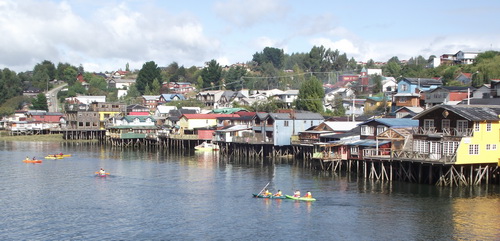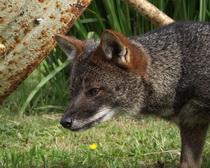The 2013 season in South America is now in close range especially as fall begins. For those of you who are looking to branch out, this is your opportunity to explore a new continent on two wheels. With the help of our tour leaders in Chile, we’re highlighting a couple of towns that we pass through on our Patagonia Lakes District Plus! tour and our Chile’s Wine Country tour in this article. Perhaps one will catch your fancy and you’ll have to see it with your own eyes.
Bicycling Patagonia’s Lakes District Plus! the Island of Chiloé
On night nine of Patagonia’s Lakes District tour, you’ll have the chance to stay in the only village on the west side of Chiloé Island. This small indigenous community looks out over the Pacific Ocean and although destroyed in a 9.4 Richter scale earthquake and tsunami in 1960, it now serves as the entrance to the beautiful Chiloé National Park. The park is the only place on Chiloé Island that wasn’t covered by ice in the last ice age and is home to several unique animals including the Magellanic Flightless Steamer-Duck, Darwin’s fox, and Chilean shrew opossum, to name a few. If you’re lucky while you explore the forest of the park, you may see a pudú (Chilean deer), or a little mountain monkey (which actually is a marsupial), both endemic to the island.
Castro
 Castro was founded in 1567 and is the third oldest city in Chile, one of the few towns established by the Spanish conquistadors not destroyed during the Mapuche revolution in 1600. The colorful stilt houses, or palafitos, that line the bay help to characterize this town as well as its churches. The church in Castro, designed by an Italian architect named Provasoli and completed in 1911, is one of the 16 churches on the island designated as a UNESCO Heritage site. The churches across the island serve as excellent examples of the meshing European and indigenous people of the island, and Castro’s church is one not to be missed.
Castro was founded in 1567 and is the third oldest city in Chile, one of the few towns established by the Spanish conquistadors not destroyed during the Mapuche revolution in 1600. The colorful stilt houses, or palafitos, that line the bay help to characterize this town as well as its churches. The church in Castro, designed by an Italian architect named Provasoli and completed in 1911, is one of the 16 churches on the island designated as a UNESCO Heritage site. The churches across the island serve as excellent examples of the meshing European and indigenous people of the island, and Castro’s church is one not to be missed.
Bicycling Chile’s Wine Country
Santa Cruz
 You’re in the heart of Chile’s central valley when you’ve reached Santa Cruz, considered the capital of the most important wines made in the country. Santa Cruz is located near the Apalta Valley, where regular temperatures during the year and the great quality of the soil make it one of the best places to procure grapes to make premium wines. Not only can you look forward to varieties of wineries on your left and right and leave knowing the process and intricacy of this art form, but you’ll be able to taste the finest at a group lunch we have at a winery on day 4 of the tour. Paired with the new world wine, you will find a tribute to the old world at the thought-provoking private collection at the Colchagua Museum that features fossils and natural history exhibits to artifacts from human pre-history to contemporary times. See Mayan, Incan, and Aztec ceramics, and handicrafts as well as gold and silver jewelry collections outstanding in the continent. The weapons, letters, documents, and artwork of conquistadors and the Jesuits also is featured in the museum. A wide-ranging collection; this museum is one that will captivate your attention and as you have the privilege to witness thousands of treasures to better understand the complexity of the Americas.
You’re in the heart of Chile’s central valley when you’ve reached Santa Cruz, considered the capital of the most important wines made in the country. Santa Cruz is located near the Apalta Valley, where regular temperatures during the year and the great quality of the soil make it one of the best places to procure grapes to make premium wines. Not only can you look forward to varieties of wineries on your left and right and leave knowing the process and intricacy of this art form, but you’ll be able to taste the finest at a group lunch we have at a winery on day 4 of the tour. Paired with the new world wine, you will find a tribute to the old world at the thought-provoking private collection at the Colchagua Museum that features fossils and natural history exhibits to artifacts from human pre-history to contemporary times. See Mayan, Incan, and Aztec ceramics, and handicrafts as well as gold and silver jewelry collections outstanding in the continent. The weapons, letters, documents, and artwork of conquistadors and the Jesuits also is featured in the museum. A wide-ranging collection; this museum is one that will captivate your attention and as you have the privilege to witness thousands of treasures to better understand the complexity of the Americas.
If any of these towns pique your interest, let your curiosity take you to the detailed itineraries online to read more about other fascinating aspects of these tours in the ‘new world!’



